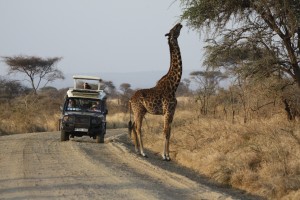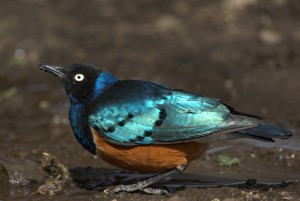Enjoy the safari of a lifetime amongst the biggest wildlife show on earth!
Tanzania has the third largest bird list of any African country with over 1,000 species including 17 endemics and a further 43 species restricted to this part of east Africa. The world famous Serengeti National Park alone, ranked at number 31 in the world’s top 100 birding locations, has over 450 bird species including 34 different raptors, 6 different vultures, 6 range restricted species and 3 endemics; Grey-breasted Spurfowl, Ashy Starling and Rufous-tailed Weaver. On this fabulous trip we also visit other birding heavens such as Tarangire National Park with a bird list of 500 species and Lake Manyara National Park with a bird list of over 400 species. But of course no one goes to a place like Tanzania just for the birds, as this is one of the top wildlife locations on earth with an abundance of big game including the ‘Big Five’; Elephant, Black Rhino, Buffalo, Lion and Leopard. Other exciting mammals include Cheetah, Wild Dog, Spotted Hyena, three species of Jackal, Caracal, Blue Wildebeest, Burchell’s Zebra, Giraffe, Warthog, Hippo, Waterbuck, Impala, Eland, Topi, Dik-dik, Thomson’s and Grant’s Gazelles, Vervet Monkey and Chacma Baboon. Our visit coincides with the world famous annual migration when over a million Wildebeest, along with half a million Zebra and a third of a million Thomson’s Gazelles congregate in the Ndutu region of the Serengeti, forming the largest mass of herbivores on earth! During February the Wildebeest drop their calves laying on a feasting bonanza for the large predators, and so the Serengeti has the world’s largest density of Lions! We will enjoy thrilling game drives through this wonderful wilderness in an open top jeep which will allow the best possible opportunities for seeing and photographing the big game, as well as all the exotic and colourful birds such as Common Ostrich, Secretary Bird, Kori Bustard, Yellow-throated Sandgrouse, Lilac-breasted Roller, Southern Ground-hornbill and the dazzling Hildebrandt’s and Superb Starlings. At this time of year the male Weavers, Bishops and Widowbirds are in their flamboyant breeding plumages and the local birds are joined by Palaearctic migrants.
This exciting safari, has been planned in conjunction with Amazing Tanzania, who have been arranging bespoke safaris in Tanzania since 1988, and throughout this fantastic trip we shall be accompanied by one of their own professional guides, who will be familiar with all the locations, their sights and sounds. Tanzania is truly amazing and with so much to see, even non-birding partners will love this trip of a lifetime.

Day 1 We have an evening flight from Heathrow to Kilimanjaro, via Addis Ababa with Ethiopian Airlines. Dinner and overnight in flight.
Day 2 We land at Addis Ababa in the morning and catch an onward flight to Kilimanjaro International Airport, arriving early afternoon, whereupon we shall be welcomed by our local guide. We have a short drive to our first base for three nights at Ngare Sero Lodge, an early twentieth century colonial farmhouse set amid lush gardens on the forested slopes of Mount Meru. Dinner and overnight at Ngare Sero Lodge.
Day 3 This morning we visit Lake Duluti, a flooded crater not far from the lodge, where a tranquil boat ride should allow close views of lots of bird life around the lake. Possibilities include Long-tailed Cormorant, Madagascar Squacco-heron, Green-backed Heron, Hammerkop, Hadada Ibis, African Fish-eagle, Palmnut Vulture, Black Crake, Grey-headed Gull, Malachite and Giant Kingfishers, Little Bee-eater, Trumpeter Hornbill, African Pied Wagtail, Yellow-vented Bulbul, African Reed Warbler and Baglafecht, Taveta Golden and Grosbeak Weavers. We return to the lodge for lunch and then explore the lodge grounds, with their own lake, on the lookout for some of the 200 birds seen here such as White-browed Coucal, White-eared Barbet, Grey-backed Cameroptera, African Paradise-flycatcher, Collared Sunbird, Montane White-eye, Black-headed Oriole, Violet-backed Starling and Black-and-white Mannikin. Dinner and overnight at Ngare Sero Lodge.
Day 4 We have a full day in nearby Arusha National Park, starting with a Ranger-led walk which may produce Tawny and Verreaux’s Eagles, Augur Buzzard, Crested and Scaly Francolins, Olive Pigeon, Red-fronted Parrot, Narina and Bar-tailed Trogons, White-fronted Bee-eater, Silvery-cheeked Hornbill, Wire-tailed Swallow, Variable Sunbird, Tropical Boubou and the lovely range restricted Hartlaub’s Turaco. We shall have a picnic lunch overlooking a lake where we should see Spur-winged Goose, Southern Pochard and Plain Martin amongst others and then in the afternoon we can enjoy a game drive in the park and should encounter our first big game animals, such as Giraffe and Buffalo, as well as Black-and-white Colobus and Blue Monkeys. Dinner and overnight at Ngare Sero Lodge.
Day 5 Today we head west to Tarangire National Park, where a game drive should produce plenty of Elephants and possibly our first Lions and Ostrich. With 500 species recorded, the bird life is prolific and specialities include dry country species like Brown Snake-eagle, African Orange-bellied Parrot, Yellow-collared Lovebird, Red-billed and Von der Decken’s Hornbills, Red-and-yellow Barbet, Nubian Woodpecker, Northern Pied Babbler, Mouse-coloured Penduline-tit, Northern White-crowned Shrike, Speckle-fronted Weaver, White-headed Buffalo-weaver, the bizarre Vulturine Guineafowl and the endemic Rufous-tailed Weaver and Ashy Starling. Dinner and overnight at Tarangire Safari Lodge.
Day 6 We have a full day to explore more of Tarangire National Park, and along the course of the Tarangire River we shall keep a particular eye open for African Pygmy Kingfisher and the awesome Saddle-billed Stork. Dinner and overnight at Tarangire Safari Lodge.
Day 7 We leave Tarangire and drive a short way north to Karatu for a three night stay at Country Lodge in five acres of tropical gardens on the edge of town. En route we shall spend the day on safari in Lake Manyara National Park, which is home to tree climbing Lions and some of the largest Baboon troops on earth! This is a birder’s paradise with a list of over 400 species including thousands of Greater and Lesser Flamingos plus White and Pink-backed Pelicans, African Spoonbill, Grey-crowned Crane, Yellow-billed and Marabou Storks, Sacred and Glossy Ibises, African Jacana, Hottentot Teal, Crowned, Spur-winged, Blacksmith, Three-banded and Chestnut-banded Plovers, Two-banded Courser, Grey-hooded Kingfisher and Eurasian visitors like Marsh Sandpiper, Black-winged Stilt, Collared Pratincole and White-winged and Whiskered Terns. Away from the lake we can also hope to see Black-chested Snake-eagle, Gabar Goshawk, Helmeted Guineafowl, Speckled Pigeon, African Green-pigeon, Emerald-spotted Wood-dove, Fischer’s Lovebird, Speckled Mousebird, Green Wood-hoopoe, Crowned Hornbill, Southern Ground-hornbill, Grey Woodpecker, Grassland Pipit, African Grey Flycatcher, Arrow-marked Babbler, Scarlet-chested Sunbird, Black-breasted and Superb Starlings, Red-billed Oxpecker, Grey-headed Sparrow, Lesser Masked Weaver, Red-billed Quelea and Red-billed Firefinch. Dinner and overnight at Country Lodge.
Day 8 We drive to the nearby award winning Gibbs Farm for a two hour hike through the forested slopes of the Ngorongoro Crater rim to a magnificent waterfall and caves where Elephants dig for minerals. The digging also attracts Buffalo, Bushbuck, Waterbuck and Baboons. Birds of the forest include Livingstone’s Turaco, White-eyed Slaty Flycatcher and Golden-winged Sunbird. We return to the farm in time for lunch and then drive back to our lodge for a ‘garden birdwatch’ and some ‘r & r’. Dinner and overnight at Country Lodge.
Day 9 This is when the fun really starts as we have a full day in the world famous Ngorongoro Crater, one of the greatest natural wonders on earth! This huge caldera is home to around 25,000 animals and a top place for seeing the rare Black Rhino. On the descent into the crater we can look out for Black Saw-wing, White-necked Raven and Schalow’s Wheatear which is endemic to the rift valley. On the crater ‘floor’ we might see White-faced Whistling-duck, Knob-billed and Yellow-billed Ducks, Hildebrandt’s Francolin, Kittlitz’s and Black-winged Plovers, Namaqua Dove, Pied Kingfisher, Red-capped Lark, Fischer’s Sparrow-lark, Long-billed Pipit, Ruby-throated Longclaw, Capped Wheatear, Northern Anteater Chat, Rufous Chatterer, Rufous Sparrow, Speke’s Weaver and Fan-tailed and Jackson’s Widowbirds, as well as all the big game, and at lunch time we can hope that the stealthy Yellow-billed Kites don’t get in first! Dinner and overnight at Country Lodge.
Day 10 We continue our journey westward through the Ngorongoro Conservation Area, dotted with traditional Masai villages, to Ndutu Safari Lodge on the perimeter of Serengeti National Park. Dinner and overnight at Ndutu Safari Lodge.
Days 11 – 14 At this time of year the Ndutu region is the epicentre of the Wildebeest migration and so we have the luxury of three full days to enjoy the spectacular wildlife show and explore the varied habitats, which include plains, marshes, woodlands, two soda lakes and the Oldupai Gorge, birthplace of our Hominid ancestors almost 2 million years ago. On top of all the fabulous big game, with high chances of seeing Lion, Leopard and Cheetah, likely birds include Black-headed and Goliath Herons, Black-shouldered Kite, all six Vultures; Hooded, White-backed, Rüppell’s Griffon, Egyptian, White-headed and the mighty Lappet-faced, plus Bateleur, Steppe, Martial and Long-crested Eagles, Pygmy Falcon, White-eyed Kestrel, Coqui Francolin, Kori and White-bellied Bustards, Chestnut-bellied and Yellow-throated Sandgrouse, Laughing and Ring-necked Doves, Mottled Swift, Lilac-breasted Roller, Rufous-naped Lark, Black Roughwing, White-browed Scrub-robin, Silverbird, Grey-backed Fiscal-shrike, Magpie Shrike, Cape Rook and Yellow-billed Oxpecker. We shall also spend a day on safari in the adjacent Serengeti National Park where the picnic sites alone will allow close views of a frenzy of bird life including Brown Parrot, Black-lored Babbler, Slate-coloured Boubou, Rüpell’s, Hildebrandt’s and Wattled Starlings, Swahili Sparrow, Grey-headed Social-weaver, Red-billed Buffalo-weaver, Red-cheeked Cordonbleu, Black-faced Waxbill and White-bellied Canary. Dinners and overnights at Ndutu Safari Lodge.
Day 15 We have a final morning at Ndutu and then drive back to ‘civilisation’ for our last night near Karatu. Dinner and overnight at Bougainvillea Lodge.
Day 16 We have a late afternoon flight home, via Addis Ababa.
Day 17 We depart Addis Ababa a little after midnight and arrive in London at 5.50am.
Cost £3975
What the price includes:
Return flights from Heathrow to Kilimanjaro, via Addis Ababa, with Ethiopian Airlines, all transport in Tanzania, fourteen nights full board en-suite accommodation, all game drives and reserve entry fees, field checklist and the services of your guides.
Deposit: £750
Single supplement: £435
Additional information:
The flight time from London to Kilimanjaro is about 15 hours 30 minutes. Both journeys involve overnight flights.
A visa costing £40 is required for British citizens to visit Tanzania.
Vaccinations are recommended for Typhoid and Hepatitis A. There is a risk of Malaria and so prophylaxis is advisable.
In February, temperatures range from 11 – 29°C. This is the ‘short dry season’, with about 3 inches of rain in February, which is about double the amount we get in the UK.
We shall be travelling in a 4 x 4 jeep with an openable top for safaris inside the national parks. The jeep is equipped with a fridge for picnic lunches and cold drinks, charging points for camera batteries and a radio for tuning into news of top sightings from other vehicles and base camps. The jeep can only carry six clients and so early booking is advisable.
We shall be staying in four different comfortable and charming accommodations, providing quality meals and a great safari atmosphere. As these places are very popular it is advisable to book as soon as possible.
The birding and game viewing offers excellent photo-opportunities and we can expect to see around 250 – 300 bird species in addition to many mammals. 
Superb Starling
